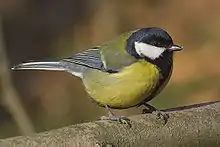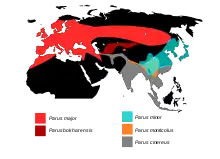| Parus | |
|---|---|
 | |
| Great tit Parus major | |
| Scientific classification | |
| Domain: | Eukaryota |
| Kingdom: | Animalia |
| Phylum: | Chordata |
| Class: | Aves |
| Order: | Passeriformes |
| Family: | Paridae |
| Genus: | Parus Linnaeus, 1758 |
| Type species | |
| Parus major (great tit) Linnaeus, 1758 | |
| Species | |
|
See text | |
 | |
| Distribution of the species in the genus Parus. Parus bokharensis is now treated as a subspecies of P. major | |
Parus is a genus of Old World birds in the tit family. It was formerly a large genus containing most of the 50 odd species in the family Paridae. The genus was split into several resurrected genera following the publication of a detailed molecular phylogenetic analysis in 2013.[1][2] The genus name, Parus, is the Latin word for "tit".
Taxonomy
The genus Parus was introduced in 1758 by the Swedish naturalist Carl Linnaeus in the tenth edition of his Systema Naturae.[3] The genus name is Latin for "tit".[4] Of the 12 species included in the genus by Linnaeus, the type species was designated as the great tit (Parus major) by George Robert Gray in 1840.[5][6]
Species
The genus now contains the following species:[2]
| Image | Scientific name | Common Name | Distribution |
|---|---|---|---|
%252C_Parc_du_Rouge-Cloitre%252C_For%C3%AAt_de_Soignes%252C_Brussels_(26194636951).jpg.webp) | Parus major | Great tit | Europe |
.JPG.webp) | Parus minor | Japanese tit | Japan and the Russian Far East beyond the Amur River, including the Kuril Islands |
 | Parus cinereus | Cinereous tit | West Asia across South Asia and into Southeast Asia. |
 | Parus monticolus | Green-backed tit | Bangladesh, Bhutan, China, India, Laos, Burma, Nepal, Pakistan, Taiwan and Vietnam. |
Fossil record
References
- ↑ Johansson, U.S.; Ekman, J.; Bowie, R.C.K.; Halvarsson, P.; Ohlson, J.I.; Price, T.D.; Ericson, P.G.P. (2013). "A complete multilocus species phylogeny of the tits and chickadees (Aves: Paridae)". Molecular Phylogenetics and Evolution. 69 (3): 852–860. doi:10.1016/j.ympev.2013.06.019. PMID 23831453.
- 1 2 Gill, Frank; Donsker, David (eds.). "Waxwings and their allies, tits & penduline tits". World Bird List Version 6.1. International Ornithologists' Union. Retrieved 15 February 2016.
- ↑ Linnaeus, Carl (1758). Systema Naturae per regna tria naturae, secundum classes, ordines, genera, species, cum characteribus, differentiis, synonymis, locis (in Latin). Vol. 1 (10th ed.). Holmiae (Stockholm): Laurentii Salvii. p. 189.
- ↑ Jobling, James A (2010). The Helm Dictionary of Scientific Bird Names. London: Christopher Helm. p. 293. ISBN 978-1-4081-2501-4.
- ↑ Gray, George Robert (1840). A List of the Genera of Birds : with an Indication of the Typical Species of Each Genus. London: R. and J.E. Taylor. p. 23.
- ↑ Paynter, Raymond A. Jr, ed. (1986). Check-list of Birds of the World. Vol. 12. Cambridge, Massachusetts: Museum of Comparative Zoology. p. 70.
- 1 2 3 Kessler, E. 2013. Neogene songbirds (Aves, Passeriformes) from Hungary. – Hantkeniana, Budapest, 2013, 8: 37-149.
Further reading
- Gill, Frank B.; Slikas, Beth & Sheldon, Frederick H. (2005): Phylogeny of titmice (Paridae): II. Species relationships based on sequences of the mitochondrial cytochrome-b gene. Auk 122: 121–143. DOI: 10.1642/0004-8038(2005)122[0121:POTPIS]2.0.CO;2 HTML abstract
This article is issued from Wikipedia. The text is licensed under Creative Commons - Attribution - Sharealike. Additional terms may apply for the media files.